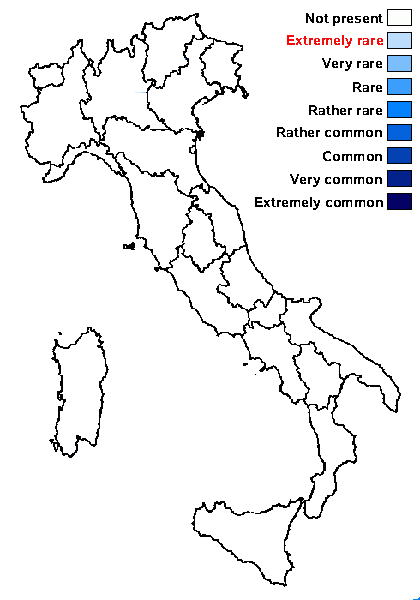Lecidea grummannii Hertel
Herzogia, 1: 28, 1968
Synonyms:
Distribution:
Description: Thallus crustose, episubstratic, pale yellowish brown, clearly glossy, consisting of convex, subpeltate areoles, forming up to 8 mm wide, rounded patches on the thalli of brown Acarospora-species. Medulla white, I-. Apothecia lecideine, black, 0.2-0.7 mm across, arranged in small clusters, at first fully immersed, then slightly projecting, with a strongly glossy, flat to weakly convex, not umbonate disc, and a thin, flexuose proper margin. Proper exciple greenish brown to dark brown in outer part, colourless within, the pigmented parts C+ red; epithecium intensely blue-green, 15-20 µm high; hymenium colourless, 50-60 µm high; paraphyses strongly coherent, mostly simple, 1.8-2.5 µm thick at mid-level, the apical cells up to 4 µm wide; hypothecium colourless to pale brown, c. 100 µm high. Asci 8-spored,clavate, Lecidea-type. Ascospores 1-celled (but often biguttulate and apparently 1-septate), hyaline, broadly ellipsoid to subglobose, 6-9 x 4-8 µm. Photobiont chlorococcoid. Spot tests cortex K-, C+ fleeting red, KC+ fleeting red, P-; medulla K-, C-, KC-, P-. Chemistry: gyrophoric acid syndrome. Note: a rare lichen, parasitic on silicicolous brown Acarospora-species, only known from the Southern Alps in Austria (Carinthia); to be looked for in the Italian Alps.
Growth form: Crustose
Substrata: rocks
Photobiont: green algae other than Trentepohlia
Reproductive strategy: mainly sexual
paras Acarospora-species

Predictive model
Growth form: Crustose
Substrata: rocks
Photobiont: green algae other than Trentepohlia
Reproductive strategy: mainly sexual
paras Acarospora-species

Predictive model
 Index Fungorum
Index Fungorum
 GBIF
GBIF

